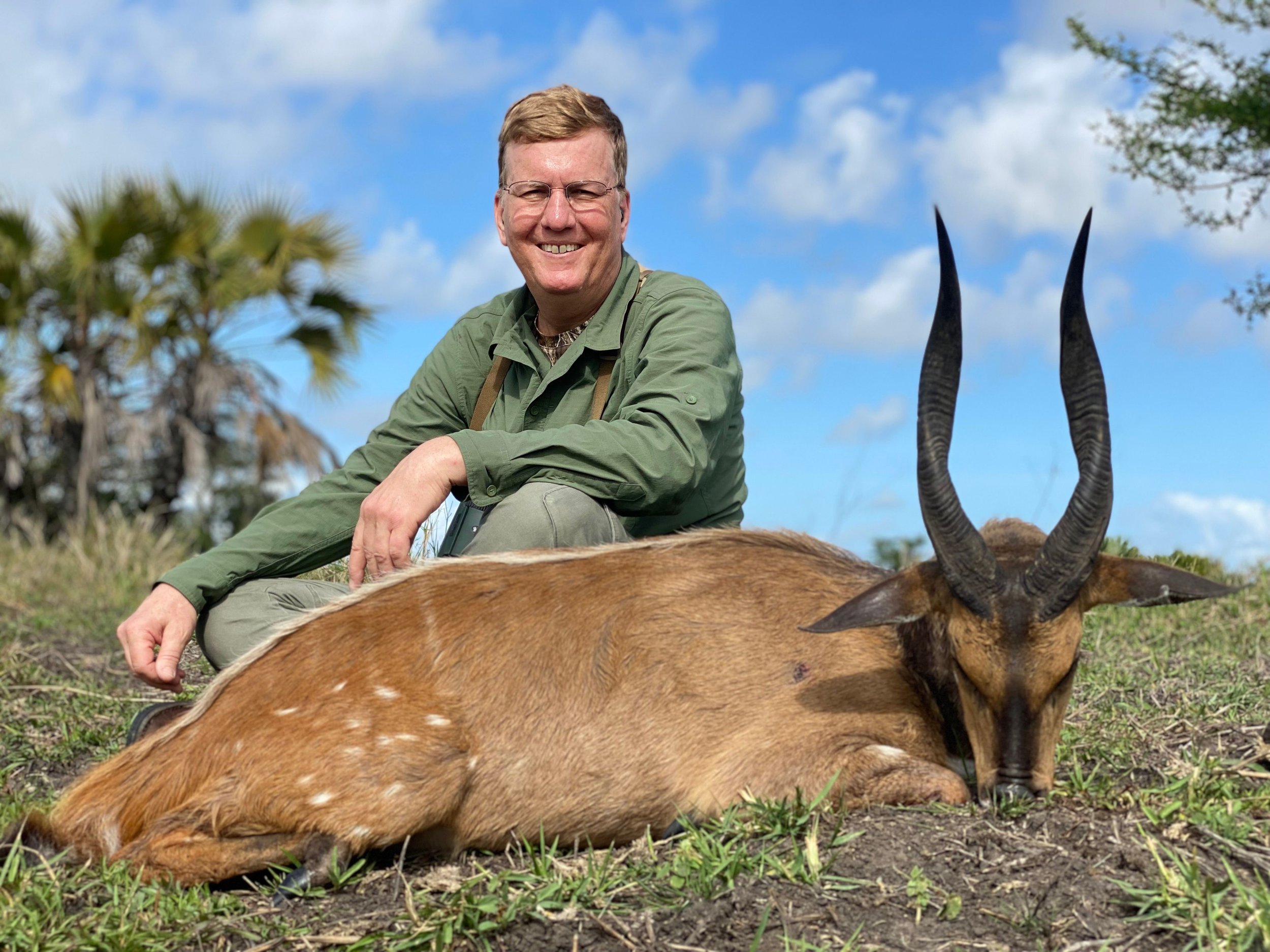A Sabbath Year: An Unexpected Consequence from COVID - Part 2
Eeny, meeny, miny, moe: A Super-abundance of Great Trophies
“I’ve never seen this many shootable trophies, let’s hold off and see if we can find something even better.” My two Coutada 11 PHs, Julian Moller and Dylan Holmes, uttered a version of that statement multiple times during my two 2021 Safaris. At some level I found it frustrating, with all the passed-up rams, bulls and boars looking very shootable to my eyes. But “Listen to your PH!” is a mantra worth adhering to. Because I did, we ended up with amazing trophies, and like my Sable, many of which exceeded the expected size-standard.
Ironically, the hunt for a so-called ‘Community’ Cape Buffalo destined not as a trophy for my wall, but to feed 60 Sena families, gives one of the best examples of the over-abundance of trophy animals in 2021. Over the tenure of Mark Haldane and his partners, the Cape Buffalo bulls taken by clients in the forests, woodlands and marshes of his concession have been good trophies, but not exceptional in terms of ‘spread’. Forty inches is the oft-quoted metric for a Cape Buffalo bull with an excellent width from one side to the other. The Coutada 11 bulls have normally fallen a bit short of that mark, so when we went out looking for a ‘meat’ bull, I expected to hear from Julian that we were seeing trophy-class bulls in the 38-inch category, while we went for something older, but narrower. Instead, time-and-again, my PH lowered his binocular from his eyes and shook his head. He would turn slowly towards me and whisper, those bulls are all over 40-inches, and the closest one will go 42-inches at least!”
The fact that we had to track three herds before we could find a sub-par bull speaks volumes to what happens when a hunting concession has a Sabbath year. Especially in a sub-tropical area so rich in food resources, the game animals will grow quickly, and without the removal of trophies, the over-abundance of larger-than-normal horns, tusks etc occur in the subsequent year(s). We did finally find a bull that met the general criteria of being substandard, but his spread would have been very good as a trophy in years past. Viva la Sabbath…
The Old, the Blind and the Lame
It turned out that there were three ways to ‘test’ my hypothesis about the effect of the COVID closures on numbers and trophy quality in Coutada 11. I almost missed one of them. The first trophy animal taken on the first of my two 2020 Safaris was a beautiful, ancient, Suni Antelope ram. In fact, he was so old that he had very little hair on his muzzle, had a large chunk missing from the base of one horn and was blind in one eye. A perfect trophy to take in all respects, likely fathering many generations – in Suni Antelope terms – of kids.
In the same ancient age-class as the Suni ram, were two other trophies, a warthog, and a bushbuck. As a matter of interest, warthogs were what alerted me to the fact that the 2020 Sabbatical year for Safaris left behind a trail of decrepit animals that would likely die before the end of 2021. Everywhere we encountered warthogs, my PH Dylan Holmes would point out emaciated boars with a staggering gait. “That hog will die of old age before next season”, was his mantra. When I asked if this was normal the answer was “I’ve never seen this many ancient hogs in Coutada 11. This is all due to not hunting them last year.” When we walked up on my trophy warthog, he too was geriatric. With a bald forehead, very little mane left, teeth worn down to the gums, and not a scrap of fat anywhere on his body, he was destined for the scavengers in the next few months.
If anything, my bushbuck ram looked even more affected by the years than either my Suni or Warthog. Taken across a deep waterway, and then carried back through chest-deep water by our ever-laboring Tracker, Albiño, the bushbuck ram was at the same time one of the most amazing animals I’ve ever seen, and one of the oldest of my trophies ever taken. His spine seemed to jut several inches above his back, with no fat and little muscle running along the ridge. His neck was completely bald, his forehead rubbed clean of hair, his ears torn, hairless and smooth as tanned leather. Looking at him, Dylan suggested, “You could buy the skin from a younger ram from the taxidermist and replace this old guy’s hide for mounting.” I replied, “I love the way this ram looks. He’s an old warrior and deserves to be remembered that way.” Dylan smiled and told me that he was glad I felt that strongly because he did as well. “It’s like wrinkles on a human face. We earn those marks. This bushbuck has earned his ancient look.”
Though not as near-death as my warthog, suni or bushbuck, two other animals taken showed their advanced ages as well. These included a Red Duiker and the Sable. The indication of many accumulated years for each of these trophies came from what scientists refer to as ‘posting’ or in common terminology ‘secondary growth’. This refers to the growth pattern at the base of a horned animal. When a horned animal reaches advanced age, the base of each horn begins to be smooth rather than ridged. The Red Duiker and Sable (and Suni and Bushbuck) had extensive, tall posting on the bases of both horns. These battlers had been around the war for many, many years…
Ancient Bushbuck

